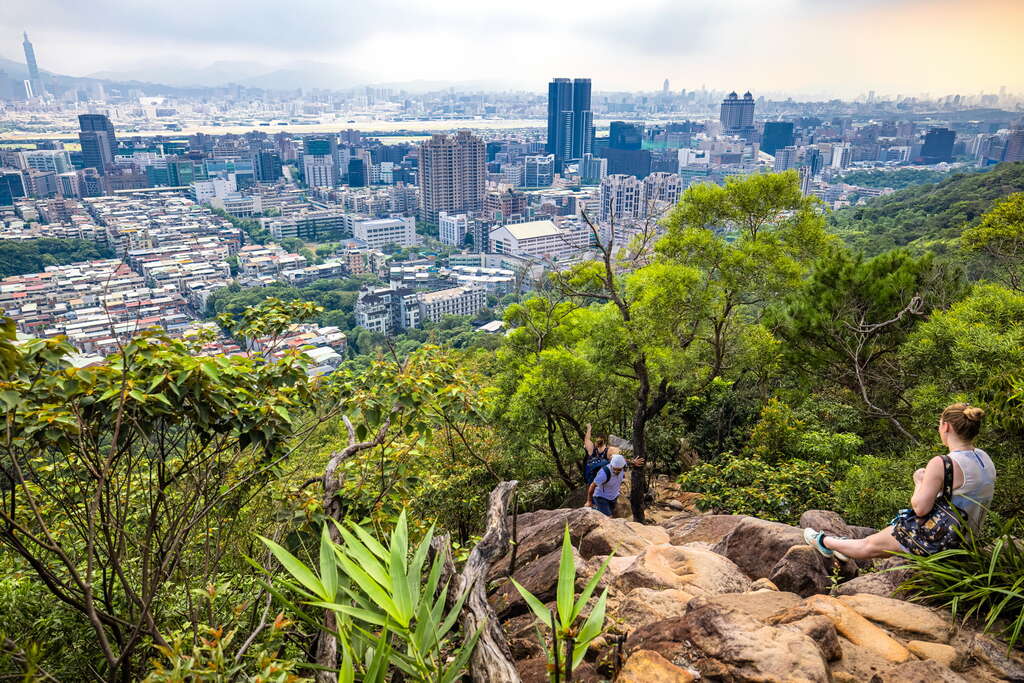Wuzhishan Mountain Range - Jinmian Mountain Qingshan Trail Introduction
Jinmian Mountain is located on the southwest ridge of the Wuzhi Mountain Range, divided into Jinmian Mountain and Xiaojinmian Mountain. The mountain's geological structure is composed of andesite sandstone containing quartz, which causes the summit to sparkle when illuminated by the sun, leading locals to call it Jinmian Mountain. The hiking trail is approximately 2.3 kilometers long, with a total distance of about 3 kilometers, taking around 1 hour and 40 minutes to walk. The Jinmian Mountain Qingshan Trail is located next to Ding Ming Institute of Technology on Huanshan Road in NeiHu. From the starting point of the trail, a nearly vertical cliff can be seen, with ancient sandstone steps along the way. As the gradient gradually increases, the stone steps are replaced by large cliffs with diameters exceeding 100 meters. At halfway up the mountain, there's a stone castle lookout point from a Qing Dynasty quarry, which serves as an obvious landmark. The summit area is a great vantage point to overlook Taipei City and the banks of the Keelung River. Continuing along the trail towards the east, after passing Xiaojinmian Mountain, one reaches near the Jinlong Zen Temple on Section 3 of Neihu Road, which is also the end part of the Qingshan Trail. Jianshi Mountain, also known as Jinmian Mountain, is located west of Jinlong Industry Road in Neihu. The summit's giant rock, viewed from the direction of Bishanyan, resembles a bird's beak, thus it is also called Jianshi Mountain. Although it stands only 258 meters above sea level, it possesses a unique mountainous grandeur. The valley was once filled with large stones used for construction during the Qing Dynasty when Taipei was being built, and the rocky terrain still bears traces of extraction. From the summit, visitors can enjoy a panoramic view of Neihu Dapedian and Taipei cityscape, with an expansive and beautiful vista. The remnants of the Qing Dynasty quarry can be found at a seemingly inconspicuous and slightly dilapidated resting area in the middle of the trail. This site is both a designated historical site and a witness to the construction of Taipei City, as most of the stone material for the Taipei City wall during the Guangxu reign was sourced from this quartz sandstone, extending from Jinmian Mountain to Xiaojinmian Mountain. Today, one can still see traces of drilling and neatly cut stones beside the resting area, marking the remnants of the quarry. Admired for its grandeur, Jinmian Mountain offers a different challenge compared to other nearby hiking trails. Upon entering the trailhead, the steep cliffs towering almost vertically above the stream set the tone for adventure. The ancient sandstone steps are narrow enough for only one person to walk at a time, and soon, massive rock formations appear alongside the path. As the slope continues to ascend, the stone path disappears entirely, replaced by imposing cliffs over one hundred meters in diameter. The imposing rocks that initially stood upright on both sides become the main feature, creating natural barriers that challenge climbers physically and mentally. Whether testing one’s bravery, stamina, or willpower, reaching the summit requires navigating this natural gym. After passing through nature's challenge, one can take a brief rest at the "Lunjian Pavilion," adorned with scenic photographs, and take the right path to soon arrive at the summit, entering the domain of Jianshi (Scissors) Rock. Jinmian Mountain is also known as Jianshi Mountain due to the shape of the summit's giant rocks which resemble a bird's beak when viewed from the direction of Bishanyan in Neihu. This area features numerous impressive rock formations, with some literally standing upright like pillars, forming a unique and breathtaking natural spectacle. Visiting Jianshi Rock is the highlight of the Jinmian Mountain expedition, offering not just a special landscape but also exceptional viewing perspectives. The quarry from the Qing Dynasty and the stone castle lookout provide excellent viewpoints for gazing at the Taipei Basin, particularly clear views along the Keelung River. Surrounded by jagged giant rocks, visitors are treated to a stunning 360-degree view: to the east, one can see the Neihu Dapedian (Bihui Park), to the north, the mountains around Bishanyan and Wuzhi Mountain; to the south, the Keelung River, Songshan Airport, Miramar Entertainment Park’s Ferris wheel, and Taipei 101; and to the west, the Taipei Basin and Keelung River. The summit offers a perfect location to overlook the urban scenery of northern Taipei, making it a worthwhile ascent. At this point, one can find a large rock jutting out from the cliff and enjoy the thrill of embracing the wind, or simply lie back and relax, releasing the tension built up from the climb. If accompanied by friends, the experience of chatting and relaxing in such an open space is incomparable to sipping afternoon tea in a city corner. Ecological Observation and Easy Walk: Leaving the Jianshi Rock area, visitors may encounter another scenic wonder: under the sunlight, the ground shimmers strikingly. While walking on the white sandstone ridge, it almost feels like stepping along a coastline. This effect is due to the quartz content in the andesite sandstone, which captivated early locals with its sparkling peak under sunlight, thus earning the name "Jinmian Mountain." The rocky environment suggests poor soil fertility, compounded by a dry climate and the impact of prevailing winds; therefore, the resilient plants that thrive here can endure hardships. On the ridgeline, flora such as Myrtus communis, Mume, Ziziphus jujuba, and other drought-resistant species can be found, while in the vicinity of the quarry, one observes clusters of white-stemmed shrubs and a notable presence of Acacia confusa. The trail features the "Baijuping" platform, the first viewpoint where one can overlook the Neihu area and Keelung River, home to the protagonist white-stemmed tree, as well as the rare spiny leaf cherry, which is only found north of the Keelung River. Along the path to the summit, species that typically grow tall in other forests become approachable, allowing for close observation. Several pavilions along the way provide perfect spots for rest while also engaging in ecological observation.




























